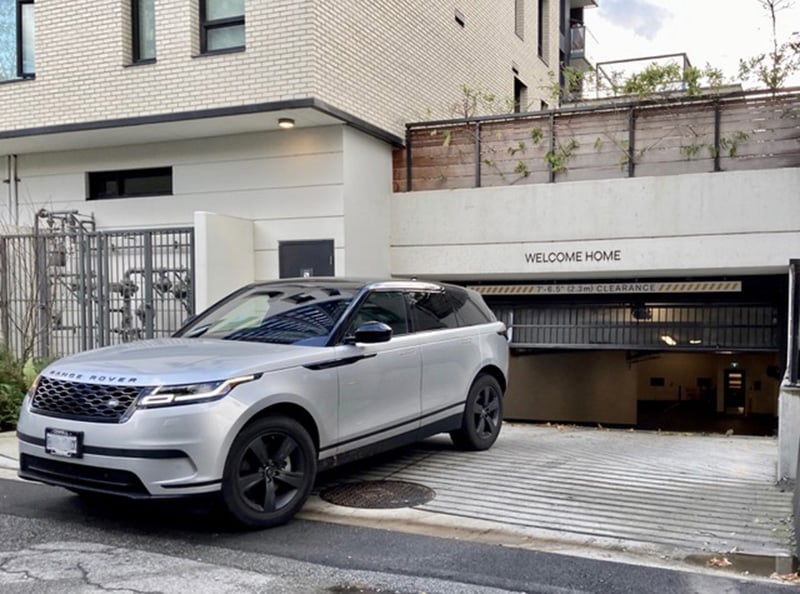Welcome to the new, 21st-century Vancouver, a city that offers you the ability to avoid engaging with your neighbourhood. You can take a short elevator ride down into the bowels of your condo or rental building, hop into your car and avoid those depressing street people. Walking to restaurants and shops won’t be necessary — you are but a short drive from the latest trendy establishment anywhere in the city. (You could take transit, but that’s for others.) Welcome to the city of gated communities.
In Vancouver, we are currently building more parking than ever. We know this not because the city tracks or limits parking as many European cities do, but because of recent development proposals.
We know it because my neighbourhood, the West End, offers a history lesson in the steadily increasing amounts of off-street parking being incorporated into multi-family residential buildings. In the early 20th century, no parking was needed or provided. In the decades up until the 1960s, we began to incorporate more parking in small main floor garages and backyards. Now, we’re building increasingly sophisticated complexes with parking in deep underground parkades. Today’s dense highrises can include parking garages between five and 11 storeys below street level.
As UCLA planning professor Donald Shoup notes in his book Parking and the City, just as a trip by rapid transit begins and ends with a transit station, a trip by automobile begins and ends in a parking space, making it an essential part of our auto infrastructure. Shoup writes that the availability of plentiful parking is a significant factor in most people’s decision on whether to use a car for a particular trip. So, if we want to reduce car use and carbon emissions in our cities, we ultimately need to provide less parking.
Underground parking also contributes to carbon emissions at the building stage. Somewhere between 20 and 60 per cent of the average building’s carbon emissions are embodied — in other words, emitted during construction. Embodied carbon is a particularly pressing issue because it’s released immediately during the short construction period rather than slowly over a long operational life cycle.
One of the biggest culprits in embodied carbon emissions is Portland cement, which is an essential ingredient in concrete, one of the most widely used building materials in the world. While recent innovations in construction mean that we can now build 30-storey highrises from mass timber, which significantly decreases an embodied carbon footprint, we still need concrete to build below grade.
On the surface, Vancouver’s planning appears moderately green. In 2012, city council passed Transportation 2040, a plan that favours walking, cycling, public transit, car share and taxis over privately-owned vehicles. Planners realized that denser neighbourhoods would be more walkable, sociable and environmentally friendly. Moreover, if people walked, biked or took transit, traffic congestion could be reduced, and Vancouverites could decrease their carbon footprint.
Transportation 2040 also called for parkades that could be shared with different users, such as car-share participants, and designed so that parking could be converted to other uses. Unfortunately, these thoughtful ideas have never been taken up in any of the large-scale development projects currently in planning or construction.
The amount of ongoing construction in Vancouver has never been greater, running to an average of about $3.03 billion per year over the past decade. Approximately 20 per cent of the average total cost of new buildings goes to below-grade parking structures. This means that over the past 10 years, we’ve spent about $6.06 billion on underground parking structures, enough to pay for a complete transit line to UBC, plus some spare change for needed additions to our bus fleet.
Several projects that have either recently been approved or are in various stages of approval typify Vancouver’s approach to underground parking.
The large Plaza of Nations, located at 750 Pacific Blvd. on False Creek, has been touted as a “green” development due to significant amounts of planting over a large, terraced mega-structure. But the project’s underground parking will extend well beyond the above-grade building footprint, which precludes the planting of large trees that could grow to legacy sizes. The site will have two levels of underground parking, and with the exception of a handful of trees along the seawall path, virtually all the “green” planting, including street trees, will be in planters over occupied space. We can expect that every tree and shrub will have to be uprooted every three or four decades. This is on a site close to two transit lines, a major bike route and adjacent to the downtown core.
The new Lululemon headquarters, to be located at 1980 Foley St., includes over 800 parking stalls in five underground levels. This proposal is on the Sixth Avenue bike route, close to an existing transit station and even closer to a new station on the Broadway line. We can predict that Lululemon staffers won’t even be particularly interested in these spots — a survey recently conducted on behalf of GWL Realty Advisors showed thatr a mere eight per cent of Vancouver’s under-35 population favoured personal cars for getting to work, and almost 60 per cent of under-45s relied on public transit.
At 2538 Birch St., a 28-storey tower will provide affordable rental housing, but its planned five storeys of below-grade parking will reduce that affordability and seems unnecessary for a building located close to the Broadway transit corridor.
At 1116 Pendrell St., the Development Permit Board recently approved a project to replace an existing affordable rental building and an existing modest strata building with a luxury tower. Under the parking bylaw, a minimum of 86 parking spaces is required, yet the proponents are planning to build 169 parking spaces. The staff report makes no mention of this, instead requiring the applicant to make small adjustments to the building to mitigate minor “shadowing” of adjacent neighbours. To borrow a cliché, this is equivalent to rearranging the deck chairs on the Titanic while ignoring the icebergs below the surface.
Overabundance of parking has become the norm in most new developments in Vancouver. The trend continues with recent projects at Broadway and Granville for an office building/transit station, Harwood and Thurlow for residential towers, and a mixed-use building on Prior Street next to the new St. Paul’s Hospital. And this is just a snapshot.
It’s true that this is not an easy issue for planners and politicians. Public pressure is in favour of more parking in neighbourhoods, not less. But if we want to reduce traffic congestion and tackle climate change, housing affordability, urban vitality and social justice, we need to reduce parking. This will take strong leadership, and new regulations.
We made a small step last October, when city council approved the Climate Emergency Action Plan, which includes three initiatives related to parking.
The first initiative calls for the implementation of citywide residential parking permits — a bold and necessary move that does away with the free use of city property for vehicle storage and would provide a reliable revenue source for our underfunded transit system.
The second requires that new buildings offer parking with free charging stations for electric vehicles. This inadvertently subsidizes private vehicles, which are more affordable for wealthier people. Electric vehicles still require energy, and those energy sources are not without environmental consequences, including increased embodied carbon with the mining of required rare earth minerals for batteries.
The third calls for the institution of parking maximums that go beyond recently removed minimums. Unfortunately, the city has made no concrete moves on this front, and many recently-approved developments betray its reticence.
But it could be a powerful step. One way to bring in parking maximums would be to limit the depth of all basements in new buildings to one storey below grade within the perimeter of the above-grade building, which is essentially how all buildings, including skyscrapers, were built before 1950.
Taking that simple step would realize significant reductions in carbon dioxide emissions, make housing cheaper, and help shift construction from the luxury market to the market for much needed affordable housing.
An object of consumer desire, cars are so ubiquitous that they seem as natural as the air. But really, they’ve only been with us for a tiny fraction of our time on Earth. Though we often feel powerless to make rational decisions about cars, we’ve reached a critical point where if we want to face up to the existential challenge of climate change, that’s exactly what we need to do. ![]()
















Tyee Commenting Guidelines
Comments that violate guidelines risk being deleted, and violations may result in a temporary or permanent user ban. Maintain the spirit of good conversation to stay in the discussion.
*Please note The Tyee is not a forum for spreading misinformation about COVID-19, denying its existence or minimizing its risk to public health.
Do:
Do not: